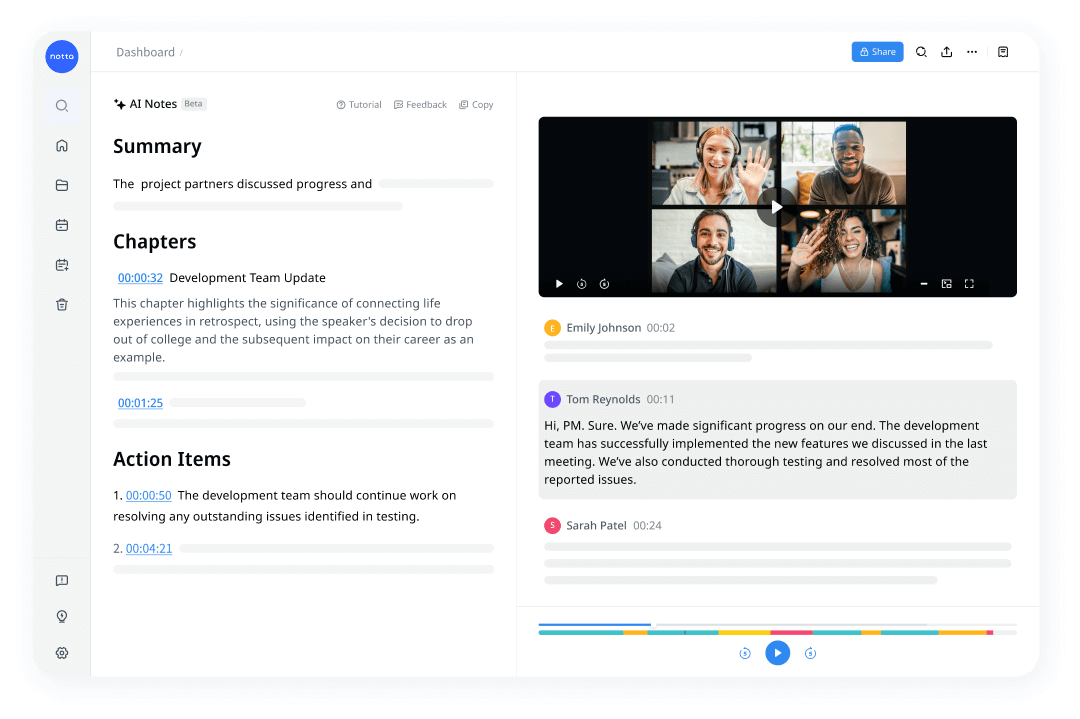Read next: How to Write the Perfect Sales Follow-up Email [+ Templates]

The Complete Guide to a Successful Discovery Meeting
Unlock the power of AI — Notta's meeting assistant records, transcribes and summarizes meeting minutes with one click.
In today's fast-paced business environment, effective communication is key to success. One of the most important tools in a salesperson's arsenal is the discovery meeting, a critical step in the sales process that can make or break a deal.
Ideally, it's a chance for both parties to know each other better and get on the same page.
This article will take a closer look at discovery meetings, why they're essential, and how you can run an excellent one. We'll also explore some tips to help you get the most out of your discovery meetings and make them as productive as possible.
What is a discovery meeting?
A discovery meeting, also known as a business discovery or sales discovery meeting, is a conversation between a salesperson and a potential customer that aims to uncover the customer's needs and goals and offer a solution tailored to their specific requirements. It is an opportunity for the salesperson to demonstrate their expertise, build rapport, and establish trust with the customer.
Discovery meetings are generally between a buyer and seller, but they can also be a way to discuss collaborative projects. For example, when two or more people work together to create something new, such as an app or website, they will often meet to figure out what the finished product should look like.
What is the purpose of a discovery meeting?
The purpose of the discovery meeting is in three folds:
Uncovering important information: The meeting allows one to ask questions and dig deeper into the other person's business or project. By learning more about their goals, challenges, and preferences, you can better understand how to help them and what they need from you.
Building trust and rapport: The meeting presents an opportunity to build trust and rapport with the client. By showing that you're interested in their needs and willing to listen and learn, you can establish a strong working relationship that will set the stage for future collaboration.
Iron out potential stumbling blocks: The meeting provides a chance to find out if there are any possible stumbling blocks before starting to work together. It also presents an opportunity to discover the different ideas shared by the other party and the various ways to address them. Reviewing the client's timeline and budget is also a good idea. For clients with a low budget cut, consider offering a less comprehensive package or find ways to reduce your fees.
During a discovery meeting, it's important to ask clarifying questions and listen actively to ensure that both parties clearly understand each other's needs and expectations. This can help build trust and establish a strong foundation for a successful partnership or sale.
How to run a discovery meeting (with examples)

Discovery meetings are essential to the selling process as they uncover valuable insights that can help them tailor their pitch and present their product or service in a way that resonates with the customer.
Here are ten tips to help you get the most out of these important sessions.
Do your research
Before the meeting, spend some time learning about the business and the person you'll be meeting with. You can do this by looking at the company website and social media accounts and, if time permits, reading up on any recent news or interviews with key employees. This research can help tailor the conversation to their needs and interests.
Send an agenda in advance
A good agenda provides a way to measure a meeting's productivity and determine the next steps after the session ends.
Sending an agenda before the discovery meeting is advisable as it lets the other person know what to expect and come prepared. It also helps everyone stay on-topic and keeps the meeting from going off-track.
An agenda can be a list of topics or a set of themes.
Start on a positive note
Beginning a discovery meeting with a friendly greeting and a positive attitude can set a constructive tone for a conversation and build rapport with the client. Clients are more likely to open up and share their concerns if they feel you are being friendly and helpful.
It is also an excellent way to help both parties stay focused, as starting with criticism or complaints can lead to an argumentative and unproductive conversation.
Focus on pain points and challenges
One of the critical goals of a discovery meeting is to find out what the other person needs or wants. To get valuable information, ask questions about their pain points or challenges. For example, what problems are they trying to solve? What do they wish they could do better?
Once you know their pain points, figure out how to help solve them. Use this opportunity to show your potential clients what they stand to benefit from working with you.
You can also share examples of how your work has helped other clients like them or present ideas to solve their problems.
Phrase your questions to get long answers
Instead of asking yes or no questions, ask open-ended questions that encourage the other person to share more information. For example, ask, "What do you hope to achieve with this project?" instead of "Do you want to increase sales?"
This will provide a longer answer and likely reveal what the client cares about. This is helpful because it gives you more insight into how to help them.
You can also try using questions that start with "how" or "why" (e.g., "How are we going to achieve this goal?") to encourage further discussion and obtain more information about what the other person wants from working with you.
Take thorough notes
Taking notes during a discovery meeting can help you remember important details and ensure there are meeting minutes to refer to. But as a salesperson, you also want to remain fully engaged to understand the client’s needs, right?
You can use the Notta AI notetaker to record the entire meeting and have all the information transcribed for future reference. This way, you'll have a complete record of the discussion during the session and can easily refer back at any time.
What's better, Notta also generates an AI summary in minutes, saving you much time is sorting notes.

Say goodbye to tedious note-taking and hello to seamless meeting transcriptions with Notta AI meeting assistant.
Showcase your expertise
A discovery meeting provides an excellent opportunity to showcase your expertise and knowledge with potential clients. During these conversations, offer insights and suggestions to help them solve problems or achieve goals.
You can further strengthen your bid by demonstrating your ability to execute similar projects successfully.
Ask about their budget
When discussing a potential project or sale, it is essential to determine the other person's budget upfront. Ask what they are willing to spend, but be sensitive to their needs and concerns.
If they say they have no budget, consider offering them a free consultation or a low-cost alternative.
Set clear next steps
After the discovery call, guide the conversation about what happens next. Do your potential clients need time to think about the project?
Are there items from the meeting that need follow-up? When would you like to meet again? What are your expectations for the next meeting, and how will you ensure they are met?
Once you establish the context, document the agreed-upon next steps in writing to ensure clarity and understanding for both parties.
Follow up
A follow-up shows that you value your client's time and are committed to building a long-term relationship with them.
After the meeting, send a thank-you note or email including the next steps. This will help establish a relationship with clients and ensure they are comfortable working with you.
By following these tips, discovery meetings can be more productive, effective, and enjoyable for everyone involved. You'll also be able to understand the clients' needs better and create a more customized plan.
Conclusion
Discovery meetings are a valuable tool for building relationships, gathering information, and identifying opportunities for improvement. By following best practices and using the right tools, you can plan and run successful discovery meetings that help you achieve your goals and maximize interactions with others.
Whether you're in sales, marketing, or driving customer success, a well-run discovery meeting can build long-term partnerships and create growth opportunities.